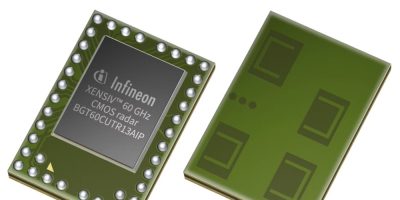Infineon launches next-generation XENSIV 60 GHz CMOS radar for low-power IoT solutions
Infineon has launched its next-generation, highly integrated 60 GHz CMOS radar sensor. Targeting ultra-low power IoT solutions, the Infineon XENSIV BGT60CUTR13AIP aims to become a key sensor for Physical AI to increase the intelligence of smart home and IoT devices. The new radar sensor is fully supported by Infineon hardware and software, third-party modules, and transferable FCC certification to aid fast-time-to-market.
The new XENSIV 60 GHz CMOS radar family includes on-chip processing powered by a hardware accelerator providing customers the flexibility to access either raw or pre-processed data. By handling radar processing on-chip Infineon’s solution offloads the host processor and supports a more efficient system architecture enabling smaller form factors and cost-efficiency. Thanks to an integrated bootloader, the XENSIV BGT60CUTR13AIP is able to run fully autonomous ultra-low power presence detection to wake-up the host, only if required.
With up to 7 GHz bandwidth and 11 dBm output power, Infineon’s XENSIV BGT60CUTR13AIP detects both moving and static targets at an extended range with up to 20 m. The cost- and footprint-optimised antenna in package (AIP) design features one transmit (Tx) and three receive (Rx) channels to enable up to 150° field of view covering both dimensions azimuth and elevation. Thus, the new XENSIV 60 GHz CMOS radar sensor enables Physical AI applications to become more intelligent and allow for more natural and intuitive interactions with users, targeting applications such as security cameras, smart thermostats, smart TVs, and HVAC systems.
Together with the integrated on-chip processing and improved radar performance, the XENSIV BGT60CUTR13AIP increases energy efficiency and extends the battery life in smart IoT devices by enabling robust, ultra-low power presence detection. This makes it well-suited for battery-powered smart home and smart building applications which interact with the user upon presence detection like video doorbells, smart displays, and smart speakers. Dedicated software stacks support advanced features including people tracking, gesture sensing, activity monitoring, and vital signs sensing so smart IoT devices can respond more naturally to their surroundings while protecting user privacy.




